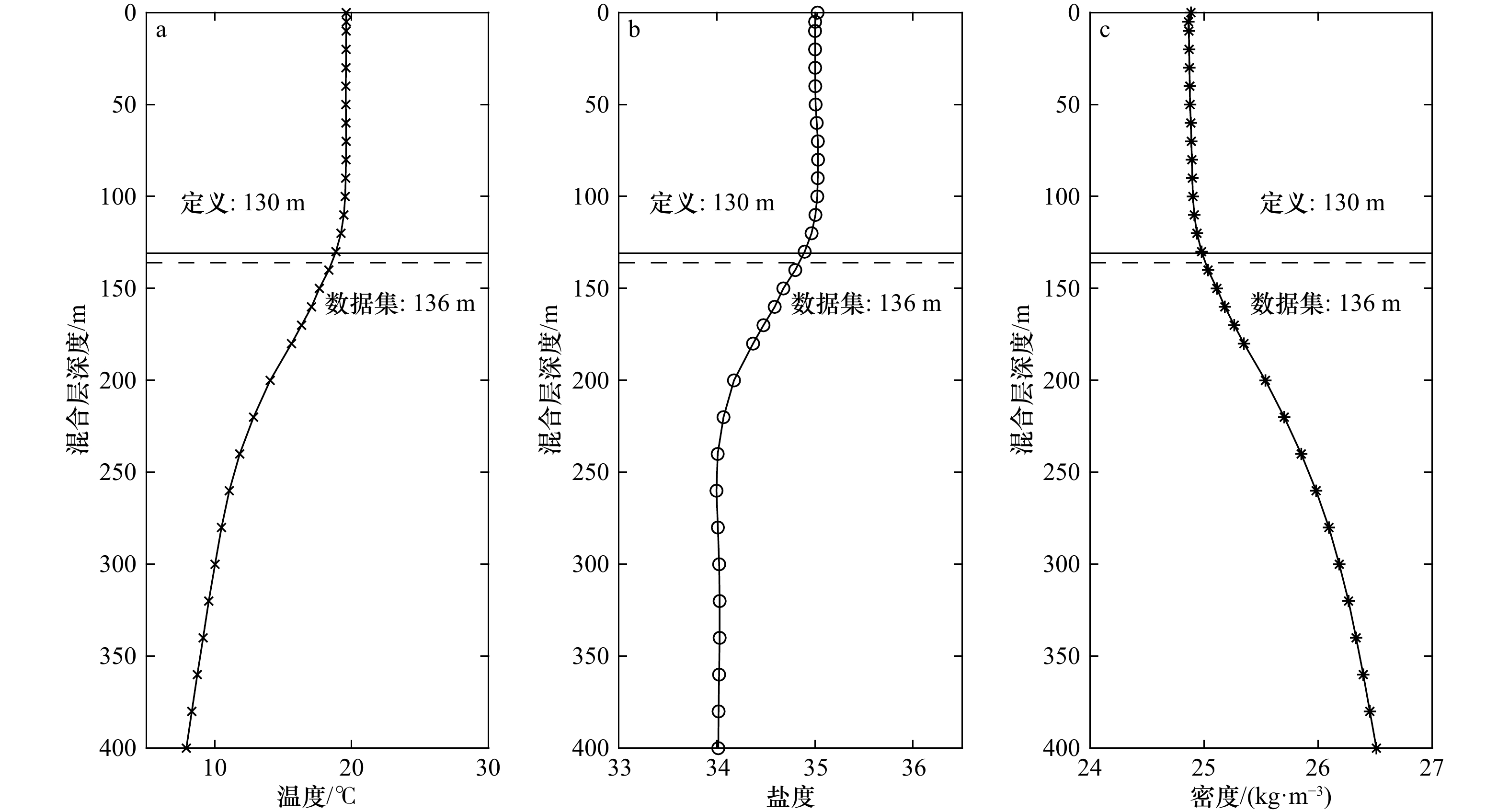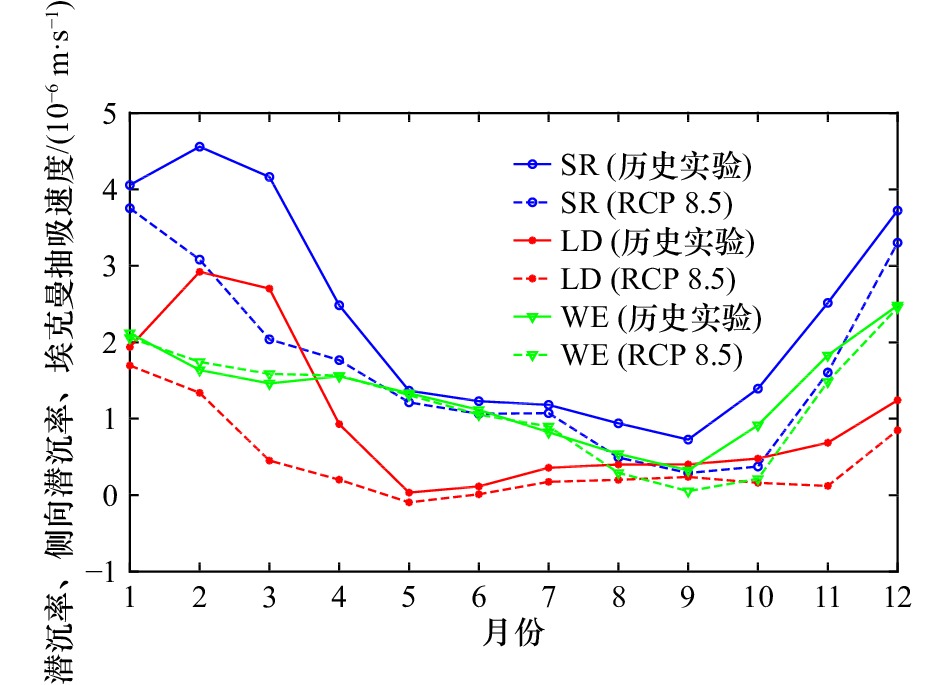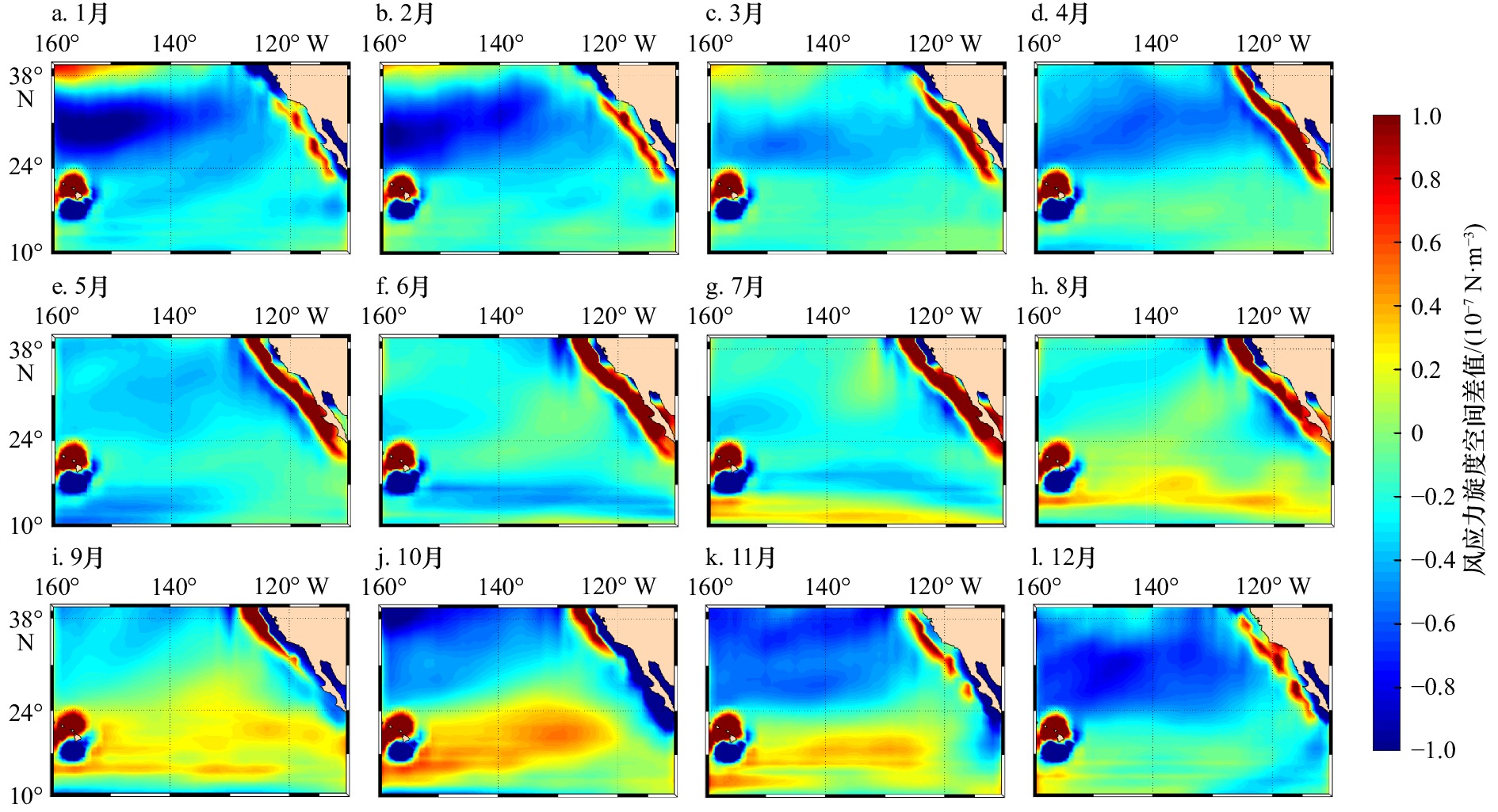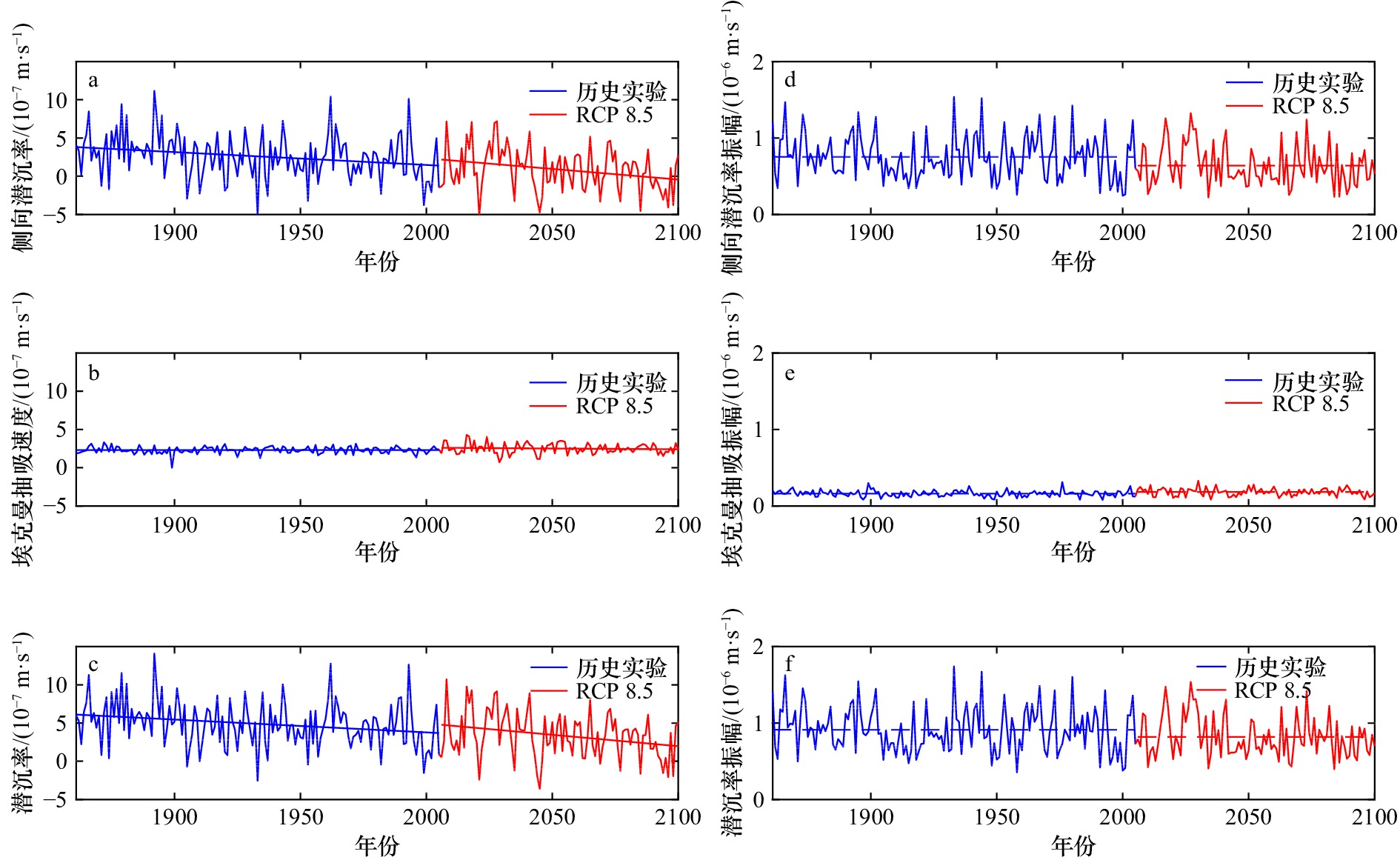Responses of seasonal cycles of the mixed layer depth and subduction rate to global warming in the subtropical Northeast Pacific
-
摘要: 本文利用第五次国际耦合模式比较计划(CMIP5)中的地球系统模式(ESM2M),结合Argo观测数据和由Ishii等整理的再分析数据集,分析现在气候背景和辐射强迫极端增强下副热带东北太平洋海域(10°~40°N,110°~160°W)混合层深度(MLD)和潜沉率的季节变化特征,研究其对全球变暖的响应。在现在气候背景下,二者最大值均出现在冬季。潜沉率的主要贡献项存在显著的季节变化差异,1−5月主要受侧向潜沉率的变化控制,6−12月则由风应力旋度导致的埃克曼抽吸速度变化主控。全球变暖后,季节循环信号的主控要素不变。但受风应力旋度等要素变化的影响,各季节的MLD减小,大值区范围收缩。由于冬季减小幅度远大于夏季,MLD季节波动幅度(振幅)显著变小。长期看,MLD呈现持续变浅的趋势,其空间不均匀性减弱引起的MLD锋面减弱是控制侧向潜沉率减弱,最终导致总潜沉率减弱的关键。由于埃克曼抽吸速度的季节变化信号对全球变暖的响应较小,因此总潜沉率在冬季受全球变暖的影响最为强烈。上述结果表明,构成潜沉率的两个关键要素对总潜沉率的贡献比例是随着季节变化而改变的:冬季MLD锋面强盛时期,侧向潜沉率的影响将显著增强。全球变暖前后二者截然不同的变化会显著改变潜沉率的季节循环振幅,可能对该区域模态水的形成和输运产生深远的影响。Abstract: Based on the Earth System Model (ESM2M) of the Coupled Model Intercomparison Project 5 (CMIP5), combined with Argo observation data and the reanalysis dataset compiled by Ishii et al., this paper presents the seasonal variation characteristics of mixed layer depth (MLD) and subduction process in the subtropical Northeast Pacific Ocean (10°−40°N, 110°−160°W) under the present climate background and extreme enhancement of radiative forcing are presented, to study its response to global warming. Under the current climate background, both of MLD and subduction rate reach their maximum values in winter. The main contribution items of subduction rate have significant seasonal variation. From January to May, the subduction rate is mainly controlled by the change of lateral induction rate, while from June to December, the main mechanism is the change of Ekman pumping velocity controlled by wind stress curl. After global warming, the main control elements of seasonal signals remain unchanged. However, under the influences of wind stress curl and other factors, the MLD in each season decreased and the range of the core maximum region shrinks. As the decrease in winter is much larger than that in summer, the seasonal fluctuation range (amplitude) of MLD is significantly smaller. In the long run, MLD shows a trend of continuous shallower, and the weakening of MLD front caused by the weakening of its spatial non-uniformity is the key to control the weakening of lateral induction rate and eventually lead to the weakening of the subduction rate. Since the seasonal variation signal of Ekman pumping velocity has little response to global warming, subduction rate is most strongly affected in winter. The results show that the contribution proportion of the two key factors to the subduction rate changes with the seasons: when the MLD front is strong in winter, the influence of the lateral induction rate will be significantly enhanced. The different variations of the two factors before and after global warming will significantly change the seasonal amplitude of the subduction rate, which may have a profound impact on the formation and transport of mode water in the region.
-
Key words:
- mixed layer depth /
- subduction rate /
- subtropical Northeast Pacific /
- global warming
-
图 2 2月份Argo数据空间平均的温度、盐度和密度垂直廓线与混合层深度
选取混合层深度大值范围为27.5°~29.5°N,137.5°~139°W;自定义混合层深度为水平实线,数据集自带混合层深度为水平虚线
Fig. 2 Vertical profile of thermohaline, density and mixed layer depth from Argo dataset in February
The range of the maximum mixed layer depth is 27.5°−29.5°N,137.5°−139°W; the solid horizontal line is the customized mixed layer depth, the dashed horizontal line is the built-in mixed layer depth of the dataset
图 5 辐射强迫极端增强前后潜沉率(左)、侧向潜沉率(中)、埃克曼抽吸速度(右)对比图
a−c. 2月历史实验;d−f. 2月辐散强迫极端增强情景实验(RCP 8.5);g−i. 7月历史实验;j−l. 7月辐散强迫极端增强情景实验(RCP 8.5);等值线为混合层深度,单位:m
Fig. 5 Subduction rate (left), lateral induction rate (center) and Ekman pumping velocity (right) before and after the enhancement of radiative forcing
a−c. The historical experiments in February; d−f. the representative concentration pathway climate forcing scenarios experiments (RCP 8.5) in February; g−i. the historical experiments in July; j-l. the representative concentration pathway climate forcing scenarios experiments (RCP 8.5) in July; the contour is mixed layer depth, unit: m
图 7 风应力旋度在辐射强迫增强前后空间差值
差值为辐散强迫极端增强情景实验(RCP 8.5)值减历史实验值;正(负)值代表向下的风应力旋度增强(减弱)
Fig. 7 Spatial difference of wind stress curl before and after the enhancement of radiative forcing
The difference is the value of representative concentration pathway climate forcing scenarios experiment (RCP 8.5) minus the value of historical experiment; positive (negative) value represents downward wind stress curl enhancement (weakening)
图 9 2月侧向潜沉率(a)、埃克曼抽吸速度(b)、潜沉率(c)及对应的季节循环振幅(d−f)长期变化
潜沉率大值区范围为21.5°~23.5°N,135°~145°W
Fig. 9 Long-term variation of lateral induction rate (a), Ekman pumping velocity (b), subduction rate (c) in February and corresponding seasonal amplitude (d−f)
The range of large subduction region is 21.5°−23.5°N,135°−145°W
-
[1] Kara A B, Rochford P A, Hurlburt H E. Mixed layer depth variability and barrier layer formation over the North Pacific Ocean[J]. Journal of Geophysical Research: Oceans, 2000, 105(C7): 16783−16801. doi: 10.1029/2000JC900071 [2] Deser C, Alexander M A, Timlin M S. Upper-ocean thermal variations in the North Pacific during 1970–1991[J]. Journal of Climate, 1996, 9(8): 1840−1855. doi: 10.1175/1520-0442(1996)009<1840:UOTVIT>2.0.CO;2 [3] Alexander M A, Timlin M S, Scott J D. Winter-to-winter recurrence of sea surface temperature, salinity and mixed layer depth anomalies[J]. Progress in Oceanography, 2001, 49(1/4): 41−61. [4] Hanawa K, Sugimoto S. ‘Reemergence’ areas of winter sea surface temperature anomalies in the world’s oceans[J]. Geophysical Research Letters, 2004, 31(10): L10303. [5] Iwasaka N, Kobashi F, Kinoshita Y, et al. Seasonal variations of the upper ocean in the western North Pacific observed by an Argo float[J]. Journal of Oceanography, 2006, 62(4): 481−492. doi: 10.1007/s10872-006-0070-6 [6] Suga T, Hanawa K. The mixed-layer climatology in the northwestern part of the North Pacific subtropical gyre and the formation area of subtropical mode water[J]. Journal of Marine Research, 1990, 48(3): 543−566. doi: 10.1357/002224090784984669 [7] Suga T, Motoki K, Aoki Y, et al. The North Pacific climatology of winter mixed layer and mode waters[J]. Journal of Physical Oceanography, 2004, 34(1): 3−22. doi: 10.1175/1520-0485(2004)034<0003:TNPCOW>2.0.CO;2 [8] Stommel H. Determination of water mass properties of water pumped down from the Ekman layer to the geostrophic flow below[J]. Proceedings of the National Academy of Sciences of the United States of America, 1979, 76(7): 3051−3055. doi: 10.1073/pnas.76.7.3051 [9] Woods J D. The physics of thermocline ventilation[J]. Elsevier Oceanography Series, 1985, 40: 543−590. [10] Sprintall J, Tomczak M. Evidence of the barrier layer in the surface layer of the tropics[J]. Journal of Geophysical Research: Oceans, 1992, 97(C5): 7305−7316. doi: 10.1029/92JC00407 [11] Sprintall J, Roemmich D. Characterizing the structure of the surface layer in the Pacific Ocean[J]. Journal of Geophysical Research: Oceans, 1999, 104(C10): 23297−23311. doi: 10.1029/1999JC900179 [12] Holte J, Talley L. A new algorithm for finding mixed layer depths with applications to Argo data and subantarctic mode water formation[J]. Journal of Atmospheric and Oceanic Technology, 2009, 26(9): 1920−1939. doi: 10.1175/2009JTECHO543.1 [13] Kraus E B, Turner J S. A one-dimensional model of the seasonal thermocline II. The general theory and its consequences[J]. Tellus, 1967, 19(1): 98−106. doi: 10.3402/tellusa.v19i1.9753 [14] Qiu B, Kelly K A. Upper-ocean heat balance in the Kuroshio extension region[J]. Journal of Physical Oceanography, 1993, 23(9): 2027−2041. doi: 10.1175/1520-0485(1993)023<2027:UOHBIT>2.0.CO;2 [15] Qiu B. The Kuroshio extension system: its large-scale variability and role in the midlatitude ocean-atmosphere interaction[J]. Journal of Oceanography, 2002, 58(1): 57−75. doi: 10.1023/A:1015824717293 [16] Keerthi M G, Lengaigne M, Drushka K, et al. Intraseasonal variability of mixed layer depth in the tropical Indian Ocean[J]. Climate Dynamics, 2016, 46(7/8): 2633−2655. [17] Chen S Y, Qiao F L, Huang C J, et al. Effects of the non-breaking surface wave-induced vertical mixing on winter mixed layer depth in subtropical regions[J]. Journal of Geophysical Research: Oceans, 2018, 123(4): 2934−2944. doi: 10.1002/2017JC013038 [18] Panassa E, Völker C, Wolf-Gladrow D, et al. Drivers of interannual variability of summer mixed layer depth in the Southern Ocean between 2002 and 2011[J]. Journal of Geophysical Research: Oceans, 2018, 123(8): 5077−5090. doi: 10.1029/2018JC013901 [19] Alraddadi T M, Alsaafani M A, Albarakati A M, et al. Seasonal variability of mixed layer depth from Argo floats in the central Red Sea[J]. Arabian Journal of Geosciences, 2021, 14(6): 496. doi: 10.1007/s12517-021-06862-5 [20] Gaube P, McGillicuddy Jr D J, Moulin A J. Mesoscale eddies modulate mixed layer depth globally[J]. Geophysical Research Letters, 2019, 46(3): 1505−1512. doi: 10.1029/2018GL080006 [21] Wang R, Cheng X H, Xu L X, et al. Mesoscale eddy effects on the subduction of North Pacific eastern subtropical mode water[J]. Journal of Geophysical Research: Oceans, 2020, 125(5): e2019JC015641. [22] Huang R X, Qiu B. Three-dimensional structure of the wind-driven circulation in the subtropical North Pacific[J]. Journal of Physical Oceanography, 1994, 24(7): 1608−1622. doi: 10.1175/1520-0485(1994)024<1608:TDSOTW>2.0.CO;2 [23] Ohno Y, Iwasaka N, Kobashi F, et al. Mixed layer depth climatology of the North Pacific based on Argo observations[J]. Journal of Oceanography, 2009, 65(1): 1−16. doi: 10.1007/s10872-009-0001-4 [24] Xia R B, Liu Q Y, Xu L X, et al. North Pacific eastern subtropical mode water simulation and future projection[J]. Acta Oceanologica Sinica, 2015, 34(3): 25−30. doi: 10.1007/s13131-015-0630-y [25] Xia R B, Liu C Y, Cheng C. On the subtropical Northeast Pacific mixed layer depth and its influence on the subduction[J]. Acta Oceanologica Sinica, 2018, 37(3): 51−62. doi: 10.1007/s13131-017-1102-3 [26] Xia R B, Li B R, Cheng C. Response of the mixed layer depth and subduction rate in the subtropical Northeast Pacific to global warming[J]. Acta Oceanologica Sinica, 2021, 40(4): 1−9. doi: 10.1007/s13131-021-1818-y [27] Kawasaki T, Tanaka S, Toba Y, et al. Long-term variability of pelagic fish populations and their environment[C]//Proceedings of the International Symposium. New York: Pergamon Press, 1991. [28] Mantua N J, Hare S R, Zhang Y, et al. A Pacific interdecadal climate oscillation with impacts on salmon production[J]. Bulletin of the American Meteorological Society, 1997, 78(6): 1069−1080. doi: 10.1175/1520-0477(1997)078<1069:APICOW>2.0.CO;2 [29] Toyoda T, Fujii Y, Kuragano T, et al. Interannual-decadal variability of wintertime mixed layer depths in the North Pacific detected by an ensemble of ocean syntheses[J]. Climate Dynamics, 2017, 49(3): 891−907. doi: 10.1007/s00382-015-2762-3 [30] Hautala S L, Roemmich D H. Subtropical mode water in the Northeast Pacific Basin[J]. Journal of Geophysical Research: Oceans, 1998, 103(C6): 13055−13066. doi: 10.1029/98JC01015 [31] Oka E, Qiu B. Progress of North Pacific mode water research in the past decade[J]. Journal of Oceanography, 2012, 68(1): 5−20. doi: 10.1007/s10872-011-0032-5 [32] Richards K J, Whitt D B, Brett G, et al. The impact of climate change on ocean submesoscale activity[J]. Journal of Geophysical Research: Oceans, 2021, 126(5): e2020JC016750. [33] Ishii M, Kimoto M, Sakamoto K, et al. Steric sea level changes estimated from historical ocean subsurface temperature and salinity analyses[J]. Journal of Oceanography, 2006, 62(2): 155−170. doi: 10.1007/s10872-006-0041-y [34] Dunne J P, John J G, Adcroft A J, et al. GFDL’s ESM2 global coupled climate-carbon earth system models. Part I: physical formulation and baseline simulation characteristics[J]. Journal of Climate, 2012, 25(19): 6646−6665. doi: 10.1175/JCLI-D-11-00560.1 [35] Taylor K E, Stouffer R J, Meehl G A. An overview of CMIP5 and the experiment design[J]. Bulletin of the American Meteorological Society, 2012, 93(4): 485−498. doi: 10.1175/BAMS-D-11-00094.1 [36] Luo Y Y, Liu Q Y, Rothstein L M. Simulated response of North Pacific mode waters to global warming[J]. Geophysical Research Letters, 2009, 36(23): L23609. doi: 10.1029/2009GL040906 [37] Williams R G. The role of the mixed layer in setting the potential vorticity of the main thermocline[J]. Journal of Physical Oceanography, 1991, 21(12): 1803−1814. doi: 10.1175/1520-0485(1991)021<1803:TROTML>2.0.CO;2 [38] Xie S P, Xu L X, Liu Q Y, et al. Dynamical role of mode water ventilation in decadal variability in the central subtropical gyre of the North Pacific[J]. Journal of Climate, 2011, 24(4): 1212−1225. doi: 10.1175/2010JCLI3896.1 [39] Xu L X, Xie S P, Liu Q Y, et al. Response of the North Pacific subtropical countercurrent and its variability to global warming[J]. Journal of Oceanography, 2012, 68(1): 127−137. doi: 10.1007/s10872-011-0031-6 [40] Cushman-Roisin B. Exact analytical solutions for elliptical vortices of the shallow-water equations[J]. Tellus A, 1987, 39(3): 235−244. doi: 10.3402/tellusa.v39i3.11756 [41] Pond S, Pickard G L. Introductory Dynamical Oceanography[M]. Oxford: Pergamon Press, 1983. [42] Toyoda T, Awaji T, Ishikawa Y, et al. Preconditioning of winter mixed layer in the formation of North Pacific eastern subtropical mode water[J]. Geophysical Research Letters, 2004, 31(17): L17206. [43] Hu H B, Liu Q Y, Zhang Y, et al. Variability of subduction rates of the subtropical North Pacific mode waters[J]. Chinese Journal of Oceanology and Limnology, 2011, 29(5): 1131−1141. doi: 10.1007/s00343-011-0237-x [44] Liu F K, Lu J, Luo Y Y, et al. On the oceanic origin for the enhanced seasonal cycle of SST in the midlatitudes under global warming[J]. Journal of Climate, 2020, 33(19): 8401−8413. doi: 10.1175/JCLI-D-20-0114.1 -





 下载:
下载:








